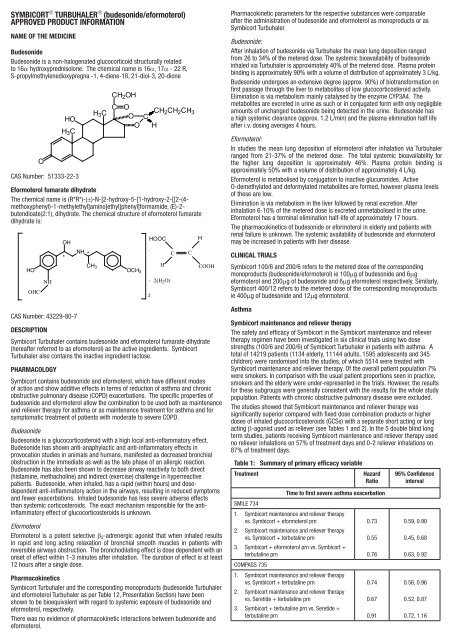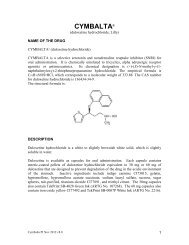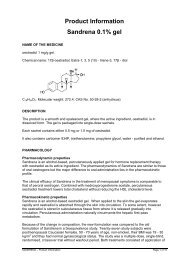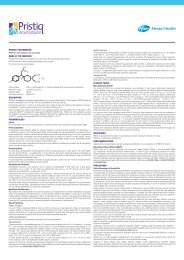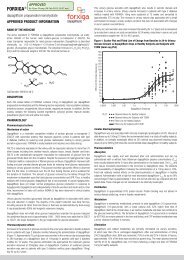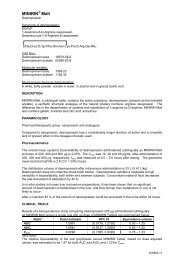Symbicort - Drivetimeradio.com.au
Symbicort - Drivetimeradio.com.au
Symbicort - Drivetimeradio.com.au
- No tags were found...
Create successful ePaper yourself
Turn your PDF publications into a flip-book with our unique Google optimized e-Paper software.
SYMBICORT ® TURBUHALER ® (budesonide/eformoterol)APPROVED PRODUCT INFORMATIONNAME OF THE MEDICINEBudesonideBudesonide is a non‐halogenated glucocorticoid structurally relatedto 16α hydroxyprednisolone. The chemical name is 16α, 17α ‐ 22 R,S‐propylmethylenedioxypregna ‐1, 4‐diene‐1ß, 21‐diol‐3, 20‐dioneOHOH 3 CCAS Number: 51333-22-3CH 2 OHH 3 C C OCH 2 CH 2 CH 3O CO HEformoterol fumarate dihydrateThe chemical name is (R*R*)-(±)-N-[2-hydroxy-5-[1-hydroxy-2-[[2-(4-methoxyphenyl)-1-methylethyl]amino]ethyl]phenyl]formamide, (E)-2-butendioate(2:1), dihydrate. The chemical structure of eformoterol fumaratedihydrate is:HOOHCNHOHCAS Number: 43229-80-7*NH *CH 3OCH 3.HOOC.2H2(H 2 O)CCHCOOHDESCRIPTION<strong>Symbicort</strong> Turbuhaler contains budesonide and eformoterol fumarate dihydrate(hereafter referred to as eformoterol) as the active ingredients. <strong>Symbicort</strong>Turbuhaler also contains the inactive ingredient lactose.PHARMACOLOGY<strong>Symbicort</strong> contains budesonide and eformoterol, which have different modesof action and show additive effects in terms of reduction of asthma and chronicobstructive pulmonary disease (COPD) exacerbations. The specific properties ofbudesonide and eformoterol allow the <strong>com</strong>bination to be used both as maintenanceand reliever therapy for asthma or as maintenance treatment for asthma and forsymptomatic treatment of patients with moderate to severe COPD.BudesonideBudesonide is a glucocorticosteroid with a high local anti-inflammatory effect.Budesonide has shown anti-anaphylactic and anti-inflammatory effects inprovocation studies in animals and humans, manifested as decreased bronchialobstruction in the immediate as well as the late phase of an allergic reaction.Budesonide has also been shown to decrease airway reactivity to both direct(histamine, methacholine) and indirect (exercise) challenge in hyperreactivepatients. Budesonide, when inhaled, has a rapid (within hours) and dosedependentanti-inflammatory action in the airways, resulting in reduced symptomsand fewer exacerbations. Inhaled budesonide has less severe adverse effectsthan systemic corticosteroids. The exact mechanism responsible for the antiinflammatoryeffect of glucocorticosteroids is unknown.EformoterolEformoterol is a potent selective b 2 -adrenergic agonist that when inhaled resultsin rapid and long acting relaxation of bronchial smooth muscles in patients withreversible airways obstruction. The bronchodilating effect is dose dependent with anonset of effect within 1-3 minutes after inhalation. The duration of effect is at least12 hours after a single dose.Pharmacokinetics<strong>Symbicort</strong> Turbuhaler and the corresponding monoproducts (budesonide Turbuhalerand eformoterol Turbuhaler as per Table 12, Presentation Section) have beenshown to be bioequivalent with regard to systemic exposure of budesonide andeformoterol, respectively.There was no evidence of pharmacokinetic interactions between budesonide andeformoterol.Pharmacokinetic parameters for the respective substances were <strong>com</strong>parableafter the administration of budesonide and eformoterol as monoproducts or as<strong>Symbicort</strong> Turbuhaler.Budesonide:After inhalation of budesonide via Turbuhaler the mean lung deposition rangedfrom 26 to 34% of the metered dose. The systemic bioavailability of budesonideinhaled via Turbuhaler is approximately 40% of the metered dose. Plasma proteinbinding is approximately 90% with a volume of distribution of approximately 3 L/kg.Budesonide undergoes an extensive degree (approx. 90%) of biotransformation onfirst passage through the liver to metabolites of low glucocorticosteroid activity.Elimination is via metabolism mainly catalysed by the enzyme CYP3A4. Themetabolites are excreted in urine as such or in conjugated form with only negligibleamounts of unchanged budesonide being detected in the urine. Budesonide hasa high systemic clearance (approx. 1.2 L/min) and the plasma elimination half lifeafter i.v. dosing averages 4 hours.Eformoterol:In studies the mean lung deposition of eformoterol after inhalation via Turbuhalerranged from 21-37% of the metered dose. The total systemic bioavailability forthe higher lung deposition is approximately 46%. Plasma protein binding isapproximately 50% with a volume of distribution of approximately 4 L/kg.Eformoterol is metabolised by conjugation to inactive glucuronides. ActiveO-demethylated and deformylated metabolites are formed, however plasma levelsof these are low.Elimination is via metabolism in the liver followed by renal excretion. Afterinhalation 6-10% of the metered dose is excreted unmetabolised in the urine.Eformoterol has a terminal elimination half-life of approximately 17 hours.The pharmacokinetics of budesonide or eformoterol in elderly and patients withrenal failure is unknown. The systemic availability of budesonide and eformoterolmay be increased in patients with liver disease.Clinical Trials<strong>Symbicort</strong> 100/6 and 200/6 refers to the metered dose of the correspondingmonoproducts (budesonide/eformoterol) ie 100mg of budesonide and 6mgeformoterol and 200mg of budesonide and 6mg eformoterol respectively. Similarly,<strong>Symbicort</strong> 400/12 refers to the metered dose of the corresponding monoproductsie 400mg of budesonide and 12mg eformoterol.Asthma<strong>Symbicort</strong> maintenance and reliever therapyThe safety and efficacy of <strong>Symbicort</strong> in the <strong>Symbicort</strong> maintenance and relievertherapy regimen have been investigated in six clinical trials using two dosestrengths (100/6 and 200/6) of <strong>Symbicort</strong> Turbuhaler in patients with asthma. Atotal of 14219 patients (1134 elderly, 11144 adults, 1595 adolescents and 345children) were randomised into the studies, of which 5514 were treated with<strong>Symbicort</strong> maintenance and reliever therapy. Of the overall patient population 7%were smokers. In <strong>com</strong>parison with the usual patient proportions seen in practice,smokers and the elderly were under-represented in the trials. However, the resultsfor these subgroups were generally consistent with the results for the whole studypopulation. Patients with chronic obstructive pulmonary disease were excluded.The studies showed that <strong>Symbicort</strong> maintenance and reliever therapy wassignificantly superior <strong>com</strong>pared with fixed dose <strong>com</strong>bination products or higherdoses of inhaled glucocorticosteroids (GCSs) with a separate short acting or longacting β-agonist used as reliever (see Tables 1 and 2). In the 5 double blind longterm studies, patients receiving <strong>Symbicort</strong> maintenance and reliever therapy usedno reliever inhalations on 57% of treatment days and 0-2 reliever inhalations on87% of treatment days.Table 1: Summary of primary efficacy variableTreatmentHazardRatioTime to first severe asthma exacerbationSMILE 7341. <strong>Symbicort</strong> maintenance and reliever therapyvs. <strong>Symbicort</strong> + eformoterol prn0.732. <strong>Symbicort</strong> maintenance and reliever therapyvs. <strong>Symbicort</strong> + terbutaline prn0.553. <strong>Symbicort</strong> + eformoterol prn vs. <strong>Symbicort</strong> +terbutaline prn0.76COMPASS 7351. <strong>Symbicort</strong> maintenance and reliever therapyvs. <strong>Symbicort</strong> + terbutaline prn0.742. <strong>Symbicort</strong> maintenance and reliever therapyvs. Seretide + terbutaline prn0.673. <strong>Symbicort</strong> + terbutaline prn vs. Seretide +terbutaline prn0.9195% Confidenceinterval0.59, 0.900.45, 0.680.63, 0.920.56, 0.960.52, 0.870.72, 1.16
STAY 6731. <strong>Symbicort</strong> maintenance and reliever therapyvs. <strong>Symbicort</strong> + terbutaline prn0.55 0.44, 0.672. <strong>Symbicort</strong> maintenance and reliever therapyvs. budesonide + terbutaline prn0.53 0.43, 0.653. <strong>Symbicort</strong> + terbutaline prn vs. budesonide +terbutaline prn0.97 0.82, 1.16STEP 668<strong>Symbicort</strong> maintenance and reliever therapy vs.budesonide + terbutaline prn 0.61 0.50, 0.74COSMOS 691<strong>Symbicort</strong> maintenance and reliever therapy vs.Seretide + Ventolin prn 0.75 0.61, 0.93Morning peak flow (L/MIN)STEAM 667<strong>Symbicort</strong> maintenance and reliever therapy vs.budesonide + terbutaline prnMean diff=25 L/min19, 31Table 2: Summary of the number of severe asthma exacerbationsTreatmentNo. ofexacerbationsNo. of patients withexacerbations/total patients (%)SMILE 734 (12 months)1. <strong>Symbicort</strong> maintenance and relievertherapy2. <strong>Symbicort</strong> + eformoterol prn3. <strong>Symbicort</strong> + terbutaline prnCOMPASS 735 (6 months)1. <strong>Symbicort</strong> maintenance andreliever therapy2. <strong>Symbicort</strong> + terbutaline prn3. Seretide + terbutaline prnSTAY 673 (12 months)1. <strong>Symbicort</strong> maintenance andreliever therapy2. <strong>Symbicort</strong> + terbutaline prn3. Budesonide + terbutaline prnSTEP 668 (12 months)1. <strong>Symbicort</strong> maintenance and relievertherapy2. Budesonide + terbutaline prnSTEAM 667 (6 months)1. <strong>Symbicort</strong> maintenance and relievertherapy2. Budesonide + terbutaline prnCOSMOS 691 (12 months)1. <strong>Symbicort</strong> maintenance and relievertherapy2. Seretide + Ventolin prn1942963771251732083035535643315464394255329143/1107 (13%)195/1137 (17%)245/1138 (22%)94/1103 (9%)126/1099 (11%)138/1119 (12%)148/922 (16%)248/906 (27%)256/925 (28%)170/947 (18%)259/943 (27%)27/354 (8%)54/342 (16%)159/1064 (15%)204/1071 (19%)Study 734 (SMILE), a 12 month randomised, double-blind, parallel-group, trial in3394 adult and adolescent patients aged 12 to 89 years with moderate to severeasthma. The study <strong>com</strong>prised of the following three arms:(1) <strong>Symbicort</strong> maintenance and reliever therapy - <strong>Symbicort</strong> Turbuhaler 200/6, 1inhalation bd plus additional inhalations as needed(2) <strong>Symbicort</strong> 200/6, 1 inhalation bd with eformoterol Turbuhaler as needed(3) <strong>Symbicort</strong> Turbuhaler 200/6, 1 inhalation bd with terbutaline Turbuhaler asneededThe primary efficacy variable, time to first severe exacerbation, was significantlyincreased with <strong>Symbicort</strong> maintenance and reliever therapy <strong>com</strong>pared with<strong>Symbicort</strong> plus eformoterol and <strong>Symbicort</strong> plus terbutaline (see Table 1).Use of oral steroids due to exacerbations was lower in the <strong>Symbicort</strong> maintenanceand reliever therapy group (1204 days total vs. 2063 and 2755 days in the<strong>Symbicort</strong> plus eformoterol and <strong>Symbicort</strong> plus terbutaline groups, respectively).The majority of secondary variables supported the superiority of <strong>Symbicort</strong>maintenance and reliever therapy over both <strong>com</strong>parators (see Table 3). Theaverage daily as-needed use in the <strong>Symbicort</strong> maintenance and reliever therapygroup was 1.02 inhalations/day and the frequency of high as-needed usewas lower for <strong>Symbicort</strong> maintenance and reliever therapy <strong>com</strong>pared to both<strong>com</strong>parators.Table 3: Secondary efficacy variables for Study 734Comparison (mean difference and 95%confidence interval)Variable †Symb.maintenance+ relieverSymb.+ eformprnSymb.+ terbprnSymbmaintenance+ relieverv Symb +eform prnSymbmaintenance+ reliever vSymb + terbprnmPEF (L/min) 15.3 10.6 7.9 4.8 (1.5, 8.0) 7.5 (4.2,10.7)ePEF (L/min) 13.8 8.5 7.5 5.4 (2.1, 8.6) 6.3 (3.1, 9.5)FEV 1 (L) 0.060 0.011 -0.016 0.049(0.024,0.075)Total asthmasymptom score(0-6)Nocturnalawakeningsdue to asthma(% nights)Symptom freedays ∆ (% days)Rescuemedication use(inhalations/24hours)-0.69 -0.57 -0.58 -0.12 (-0.18,-0.06)-16.0 -14.0 -13.5 –2.0 (-3.7,-0.4)31.3 28.9 29.4 2.4 (-0.3,5.0)-0.84 -0.67 -0.64 –0.17 (-0.25,-0.08)0.076 (0.050,0.101)-0.11 (-0.17,-0.05)–2.6 (-4.3,-0.9)1.9 (-0.8,4.6)-0.20 (-0.28,-0.11)† Mean change from mean of run-in to mean of the treatment period; mPEF – morning peakexpiratory flow; ePEF – evening peak expiratory flow; FEV 1 – forced expiratory volume in 1second; ∆ day and night with no symptoms and a night with no awakenings.The study specifically demonstrates that both the budesonide and the eformoterol<strong>com</strong>ponents of <strong>Symbicort</strong> contribute to improved asthma control achieved throughthe as-needed dosing of <strong>Symbicort</strong> within the <strong>Symbicort</strong> maintenance and relievertherapy concept.Study 735 (COMPASS), a 6 month randomised, double-blind, parallel-group trial in3335 adult and adolescent patients aged 11 to 83 years. The study <strong>com</strong>pared thefollowing three arms:(1) <strong>Symbicort</strong> maintenance and reliever therapy - <strong>Symbicort</strong> Turbuhaler 200/6, 1inhalation bd plus additional inhalation as needed(2) Seretide Inhaler 125/25, 2 inhalations bd with terbutaline Turbuhaler asneeded(3) <strong>Symbicort</strong> Turbuhaler 400/12, 1 inhalation bd with terbutaline Turbuhaleras neededThe primary efficacy variable, time to first severe exacerbation, was significantlyincreased with <strong>Symbicort</strong> maintenance and reliever therapy <strong>com</strong>pared withboth Seretide plus terbutaline and <strong>Symbicort</strong> at a higher maintenance dose plusterbutaline (see Table 1).Use of oral steroids due to exacerbations was lower in the <strong>Symbicort</strong> maintenanceand reliever therapy group <strong>com</strong>pared to Seretide plus terbutaline and <strong>Symbicort</strong>plus terbutaline (619 days total use vs. 1132 and 1044 days, respectively).Results for secondary variables, including lung function, mean use of as-neededmedication and symptom variables, were not significantly different between<strong>Symbicort</strong> maintenance and reliever therapy and the other two groups. Theaverage daily as-needed use in the <strong>Symbicort</strong> maintenance and reliever therapygroup was 1.02 inhalations/day.Since the mean daily dose in the <strong>Symbicort</strong> maintenance and reliever therapygroup remained lower than in the <strong>Symbicort</strong> plus terbutaline group, the studyspecifically confirms the benefit of as-needed administration of part of the<strong>Symbicort</strong> dose.Study 673 (STAY), Study 668 (STEP) and Study 667 (STEAM)In Studies 673, 668 and 667, <strong>Symbicort</strong> maintenance and reliever therapyprolonged the time to the first exacerbation <strong>com</strong>pared to <strong>Symbicort</strong> at the samemaintenance dose with terbutaline as reliever and <strong>com</strong>pared to a 2- to 4-foldhigher maintenance dose of budesonide with terbutaline as reliever (see Table 1).Symptoms and reliever use were reduced and lung function improved <strong>com</strong>paredwith all other treatments (see Tables 4, 5 and 6).
Table 4: Secondary efficacy variables for Study 673Variable †Symb.maintenance+ relieverSymb.+ terbprnComparison (mean difference and 95%confidence interval)Bud.+ terbprnSymbmaintenance+ reliever vSymb + terbprnmPEF (L/min) 29.9 22.0 13.0 7.9 (4.2,11.7)ePEF (L/min) 26.5 18.3 9.2 8.3 (4.5,12.0)FEV 1 (L) 0.22 0.15 0.12 0.075(0.044,0.106)Total asthmasymptom score(0-6)Nocturnalawakeningsdue to asthma(% nights)Symptom freedays ∆ (% days)Rescuemedication use(inhalations/24hours)-0.68 -0.59 -0.46 –0.09 (-0.16,-0.02)-12.7 -8.8 -8.4 –3.9 (-5.4,-2.3)29.1 28.2 21.6 0.9 (-1.9,3.8)-1.40 -1.18 -0.93 –0.22 (-0.33,-0.11)Symbmaintenance+ reliever vBud + terbprn16.9 (13.2,20.7)17.4 (13.7,21.1)0.102 (0.071,0.132)–0.21 (-0.28,-0.15)–4.3 (-5.9,-2.7)7.5 (4.6,10.3)–0.46 (-0.57,-0.35)†Mean change from mean of run-in to mean of the treatment period; mPEF – morning peakexpiratory flow; ePEF – evening peak expiratory flow; FEV 1 – forced expiratory volume in 1second; ∆ day and night with no symptoms and a night with no awakenings.Table 5: Secondary efficacy variables for Study 668Comparison (mean differenceand 95% confidence interval)Variable †Symb.maintenance+ relieverBud. + terbprnSymb maintenance + reliever vBud + terb prnmPEF (L/min) 34.2 13.9 20.3 (16.5, 24.1)ePEF (L/min) 21.8 7.9 14.0 (10.4, 17.5)FEV 1 (L) 0.19 0.09 0.100 (0.071, 0.130)Total asthmasymptom score(0-6)-0.81 -0.61 –0.21 (-0.28, -0.13)Nocturnalawakeningsdue to asthma(% nights)Symptom freedays ∆ (% days)-13.8 -10.6 –3.3 (-4.8, -1.7)33.1 25.7 7.5 (4.5, 10.4)Rescue-0.99 -0.55 –0.44 (-0.54, -0.34)medication use(inhalations/24hours)†Mean change from mean of run-in to mean of the treatment period; mPEF – morning peakexpiratory flow; ePEF – evening peak expiratory flow; FEV 1 – forced expiratory volume in 1second; ; ∆ day and night with no symptoms and a night with no awakenings.Table 6: Secondary efficacy variables for Study 667Comparison (mean differenceand 95% confidence interval)Variable †Symb.maintenance+ relieverBud. + terbprnSymb maintenance + reliever vBud + terb prnNocturnal-8.3 -6.1 –2.2 (-4.5, 0.01)awakeningsdue to asthma(% nights)Symptom free 26.8 20.2 6.5 (2.0, 11.0)days ∆ (% days)Rescue-0.68 -0.34 -0.34 (-0.51, -0.17)medication use(inhalations/24hours)†Mean change from mean of run-in to mean of the treatment period; ePEF – evening peakexpiratory flow; FEV 1 – forced expiratory volume in 1 second; ∆ day and night with nosymptoms and a night with no awakenings.Study 691 (COSMOS) was a 12-month, randomised, open, parallel group trial that<strong>com</strong>pared the effectiveness of <strong>Symbicort</strong> maintenance and reliever therapy withSeretide plus Ventolin in steroid-treated adult and adolescent patients (N=2143)aged 12 to 84 years with asthma. Randomised treatment started with a 4-weekperiod during which the maintenance doses were fixed, followed by 11 monthswhere the maintenance dose was adjusted to the lowest dose required forsymptom control (see Table 7).Table 7: Treatments in the COSMOS (691) study<strong>Symbicort</strong> maintenance andreliever therapyFixed dose period(4 weeks)Dose adjustmentperiod(11 months)<strong>Symbicort</strong> 200/6, 2 inhalationsbd with additional inhalationsas needed<strong>Symbicort</strong> 200/6 either– 2 inhalations bd plus asneeded, or– 1 inhalation bd plus asneeded, or– 2 inhalations od plus asneededSeretide plus VentolinSeretide 250/50, 1 inhalation bdplus Ventolin as neededEither– Seretide 500/50, 1inhalation bd plus Ventolinas needed– Seretide 250/50, 1inhalation bd plus Ventolinas needed, or– Seretide 100/50, 1inhalation bd plus Ventolinas neededThis study showed that <strong>Symbicort</strong> maintenance and reliever therapy treatment ismore effective than adjustable therapy with Seretide plus Ventolin in controllingasthma in adults and adolescents. <strong>Symbicort</strong> maintenance and reliever therapyincreased the time to first severe asthma exacerbations, reduced the total numberof severe asthma exacerbations (see Tables 1 and 2), reduced use of oral steroidsfor severe asthma exacerbations, and reduced use of as needed medications as<strong>com</strong>pared with Seretide at a similar daily inhaled GCS dose.Safety in the <strong>com</strong>bined studies<strong>Symbicort</strong> maintenance and reliever therapy treatment has a safety profile thatis similar to budesonide and <strong>Symbicort</strong> maintenance therapy with a decrease inasthma-related adverse events.<strong>Symbicort</strong> maintenance therapyThe efficacy and safety of <strong>Symbicort</strong> for maintenance therapy has been evaluatedin seven randomised, double-blind, double dummy, active controlled, parallelgroup studies. All treatment arms in these studies used a short-acting b 2 -agonistfor rescue use. Six studies were conducted for 12 weeks (100/6 and 200/6presentations) while the 400/12 presentation study was conducted for 24 weeks(12 weeks efficacy and additional 12 weeks safety). Efficacy and safety datawere collected for 3340 mild to moderate/severe asthmatic patients (2411 adults,128 adolescents, 801 children aged 4 to 11 years old); 1704 were treated with<strong>Symbicort</strong>.<strong>Symbicort</strong> 100/6 and 200/6In one study the maximum re<strong>com</strong>mended maintenance dose of <strong>Symbicort</strong> 200/6(2 inhalations twice daily) was <strong>com</strong>pared to corresponding 1 doses of the free<strong>com</strong>bination (budesonide Turbuhaler 200mg + eformoterol Turbuhaler 6mg, twoinhalations twice daily) and budesonide Turbuhaler 200mg (2 inhalations twicedaily) only in adults with moderate asthma (mean FEV 1 73.8% predicted normaland reversibility 22.5%). Table 8 details the efficacy results after 12 weekstreatment.1 More correct way of expressing doseePEF (L/min) 25.4 6.6 18.8 (13.3, 24.3)FEV 1 (L) 0.21 0.06 0.148 (0.103, 0.193)Total asthmasymptom score(0-6)-0.55 -0.38 –0.17 (-0.26, -0.07)
Table 8: Estimated treatment means and treatment contrasts: effectsof 12 weeks treatment with twice daily <strong>Symbicort</strong> 200/6,budesonide 200mg alone and the free <strong>com</strong>bination of themonoproductsVariable† Symb. Bud. Free<strong>com</strong>b.Change † in mPEF §(L/min)Comparison p valuesSymb v Bud.Symb v Free<strong>com</strong>b.35.7 0.2 32
Study 629In Study 629, efficacy was evaluated over 12 months using the co-primaryendpoints of post-dose FEV 1 and number of severe COPD exacerbations (defined asintake of a course of oral steroids and/or antibiotics and/or hospitalisation due torespiratory symptoms).• <strong>Symbicort</strong> Turbuhaler significantly improved mean FEV 1 <strong>com</strong>pared withplacebo and budesonide by 15% (p
in higher than re<strong>com</strong>mended doses, inhaled steroids may have adverse effects;possible systemic effects of inhaled steroids include depression of the HPA axis,reduction of bone density, cataract and gl<strong>au</strong><strong>com</strong>a, and retardation of growth ratein children. In steroid-dependent patients, prior systemic steroid usage may bea contributing factor but such effects may occur amongst patients who use onlyinhaled steroids regularly.HPA axis suppression and adrenal insufficiency:Dose-dependant HPA axis suppression (as indicated by 24 hour urinary and/orplasma cortisol AUC) has been observed with inhaled budesonide, although thephysiological circadian rhythms of plasma cortisol were preserved. This indicatesthat the HPA axis suppression represents a physiological adaption in response toinhaled budesonide, not necessarily adrenal insufficiency. The lowest dose thatresults in clinically relevant adrenal insufficiency has not been established. Veryrare cases of clinically relevant adrenal dysfunction have been reported in patientsusing inhaled budesonide at re<strong>com</strong>mended doses.Clinically important disturbances of the HPA axis and/or adrenal insufficiencyinduced by severe stress (eg tr<strong>au</strong>ma, surgery, infection in particular gastroenteritisor other conditions associated with severe electrolyte loss) may be related toinhaled budesonide in specific patient populations. These are patients withprolonged treatment at the highest re<strong>com</strong>mended dose of <strong>Symbicort</strong> and patientsadministered con<strong>com</strong>itant CYP3A4-inhibitors (see Interactions with other drugs).Monitoring for signs of adrenal dysfunction is advisable in these patient groups.For these patients additional systemic glucocorticosteroid treatment should beconsidered during periods of stress, a severe asthma attack or elective surgery.Bone density:Whilst corticosteroids may have an effect on bone mass at high doses, long termfollow up (3 - 6 years) studies of budesonide treatment in adults at re<strong>com</strong>mendeddoses, have not demonstrated a negative effect on bone mass <strong>com</strong>pared to placebo,including one study conducted in patients with a high risk of osteoporosis. Thelowest dose that does effect bone mass has not been established.Bone mineral density measurements in children should be interpreted with c<strong>au</strong>tionas an increase in bone area in growing children may reflect an increase in bonevolume. In three large medium to long term (12 months - 6 years) studies inchildren (5-16 years), no effects on bone mineral density were observed aftertreatment with budesonide (189 - 1322mg/day) <strong>com</strong>pared to nedocromil, placeboor age matched controls. However, in a randomised 18 month paediatric study(n=176; 5-10 years), bone mineral density was significantly decreased by 0.11g/cm 2 (p=0.023) in the group treated with inhaled budesonide via Turbuhaler<strong>com</strong>pared with the group treated with inhaled disodium cromoglycate. The doseof budesonide was 400mg b.i.d for 1 month, 200mg bd for 5 months and 100mgb.i.d for 12 months and the dose of disodium cromoglycate 10mg t.i.d. The clinicalsignificance of this result remains uncertain.Growth:Long term studies show that children treated with inhaled budesonide ultimatelyachieve adult target height. However, an initial reduction of growth velocity(approximately 1cm) has been observed and is generally within the firstyear of treatment. Rare individuals may be exceptionally sensitive to inhaledcorticosteroids. Height measurements should be performed to identify patientswith increased sensitivity. The potential growth effects of prolonged treatmentshould be weighed against the clinical benefit. To minimise the systemic effects ofinhaled corticosteroids, each patient should be titrated to his/her lowest effectivedose (see DOSAGE & ADMINISTRATION section).Infections / tuberculosisSigns of existing infection may be masked by the use of high doses ofglucocorticosteroids and new infections may appear during their use. Special careis needed in patients with active or quiescent pulmonary tuberculosis or fungal,bacterial or viral infections of the respiratory system.Sensitivity to sympathomimetic aminesIn patients with increased susceptibility to sympathomimetic amines (e.g.inadequately controlled hyperthyroidism), eformoterol should be used with c<strong>au</strong>tion.Cardiovascular disordersb 2 -agonists have an arrhythmogenic potential that must be considered before<strong>com</strong>mencing treatment for bronchospasm.The effects of eformoterol in acute as well as chronic toxicity studies were seenmainly on the cardiovascular system and consisted of hyperaemia, tachycardia,arrhythmias and myocardial lesions. These are known pharmacologicalmanifestations seen after administration of high doses of b 2 -adrenoceptoragonists.Patients with pre-existing cardiovascular conditions may be at greater riskof developing adverse cardiovascular effects following administration of b 2 -adrenoreceptor agonists. C<strong>au</strong>tion is advised when eformoterol is administered topatients with severe cardiovascular disorders such as ischaemic heart disease,tachyarrythmias or severe heart failure.HypokalaemiaHigh doses of b 2 -agonists can lower serum potassium by inducing a redistributionof potassium from the extracellular to the intracellular <strong>com</strong>partment, via stimulationof Na + /K + -ATPase in muscle cells.Potentially serious hypokalaemia may result. Particular c<strong>au</strong>tion is advisedin acute exacerbation as the associated risk may be <strong>au</strong>gmented by hypoxia.The hypokalaemic effect may be potentiated by con<strong>com</strong>itant treatments (seePRECAUTIONS - Interactions with other drugs section). Patients receiving digoxinare particularly sensitive to hypokalaemia. Serum potassium levels shouldtherefore be monitored in such situations.DiabetesDue to the blood-glucose increasing effects of b 2 -stimulants extra blood glucosecontrols are initially re<strong>com</strong>mended when diabetic patients are <strong>com</strong>menced oneformoterol.Impaired renal and hepatic functionThe effect of decreased liver and kidney function on the pharmacokinetics ofeformoterol and budesonide are not known. As budesonide and eformoterolare primarily eliminated via hepatic metabolism an increased exposure can beexpected in patients with severe liver disease.Other<strong>Symbicort</strong> Turbuhaler contains lactose (
uterine contractility, due to a relaxant effect on uterine smooth muscle, <strong>Symbicort</strong>Turbuhaler should be used during labour only if the potential benefit justifies thepotential risk.Budesonide: Results from a large prospective epidemiological study and fromworldwide post marketing experience indicate no adverse effects of inhaledbudesonide during pregnancy on the health of the fetus or newborn child.If treatment with glucocorticosteroids during pregnancy is unavoidable, inhaledcorticosteroids such as budesonide should be considered due to their lowersystemic effect. The lowest effective dose of budesonide to maintain asthmacontrol should be used.Eformoterol: No teratogenic effects were observed in rats receiving eformoterolfumarate at doses up to 60 mg/kg/day orally or 1.2 mg/kg/day by inhalation.Fetal cardiovascular malformations were observed in one study in whichpregnant rabbits were dosed orally at 125 or 500 mg/kg/day during the period oforganogenesis, but similar results were not obtained in another study at the samedose range. In a third study, an increased incidence of subcapsular hepatic cystswas observed in fetuses from rabbits dosed orally at 60 mg/kg/day. Decreasedbirth weight and increased perinatal/postnatal mortality were observed wheneformoterol fumarate was given to rats at oral doses of 0.2 mg/kg/day or greaterduring late gestation.Use in lactationBudesonide is excreted in breast milk. However, due to the relatively low dosesused via the inhalational route the amount of drug present in the breast milk, if any,is likely to be low.It is not known whether eformoterol is excreted in human milk. In reproductivestudies in rats eformoterol was excreted into breast milk. There are no wellcontrolledhuman studies of the use of <strong>Symbicort</strong> Turbuhaler in nursing mothers.Administration of <strong>Symbicort</strong> to women who are breastfeeding should only beconsidered if the expected benefit to the mother is greater than any possible risk tothe child.Use In children<strong>Symbicort</strong> is not re<strong>com</strong>mended for children below 12 years of age.ADVERSE REACTIONSSince <strong>Symbicort</strong> Turbuhaler contains both budesonide and eformoterol, the sameadverse effects as reported for these substances may be expected. No increasedincidence of adverse reactions has been seen following concurrent administrationof the two <strong>com</strong>pounds. The most <strong>com</strong>mon drug related adverse reactions arepharmacologically predictable side-effects of b 2 -agonist therapy, such as tremorand palpitations. These tend to be mild and usually disappear within a few days of<strong>com</strong>mencing treatment.If oropharyngeal candidiasis develops, it may be treated with appropriate anti-fungaltherapy whilst still continuing with <strong>Symbicort</strong> therapy. The incidence of candidiasiscan generally be held to a minimum by having patients rinse their mouth out withwater after inhaling their maintenance dose.Adverse reactions, which have been associated with budesonide, eformoterol and<strong>Symbicort</strong>, are given in Table 11 below.Table 11: Tabulation of adverse reactionsCommon Cardiac disorders1 to 10%Un<strong>com</strong>mon0.1 to 1%Infections and infestationsNervous system disordersRespiratory:, thoracic andmediastinal disordersCardiac disordersGastrointestinal disordersMetabolism and nutritiondisordersMusculoskeletal and connectivetissue disordersPalpitationsCandida infections in theoropharynxHeadache, tremorMild irritation in the throat,coughing, hoarsenessTachycardiaN<strong>au</strong>sea, diarrhoeaWeight gainMuscle crampsEffect on ability to drive and use or operate machinesDriving or using machinery should be undertaken with c<strong>au</strong>tion until the effect of<strong>Symbicort</strong> Turbuhaler on the individual is established. <strong>Symbicort</strong> Turbuhaler doesnot generally affect the ability to drive or use machinery.Nervous system disordersPsychiatric disordersDizziness, bad taste, thirst,tirednessAgitation, restlessness,nervousness, sleep disturbancesInteractions with other DrugsPharmacokinetic interactionsThe metabolism of budesonide is primarily mediated by the enzyme CYP3A4.Inhibitors of this enzyme, e.g. ketoconazole, may therefore increase systemicexposure to budesonide. This is of limited clinical importance for short-term (1-2weeks) treatment with ketoconazole, but should be taken into consideration duringlong-term treatment with ketoconazole or other potent CYP3A4 inhibitors.Pharmacodynamic interactionsNeither budesonide nor eformoterol have been observed to interact with any otherdrug used in the treatment of asthma or COPD.b-receptor blocking agents:b-receptor blocking agents, especially those that are non-selective, may partiallyor totally inhibit the effect of b 2 -agonists. These drugs may also increase airwayresistance, therefore the use of these drugs in asthma patients is not re<strong>com</strong>mended.Other sympathomimetic agents:Other b-adrenergic stimulants or sympathomimetic amines such as ephedrineshould not be given con<strong>com</strong>itantly with eformoterol, since the effects will becumulative. Patients who have already received large doses of sympathomimeticamines should not be given eformoterol.Xanthine derivatives, mineralocorticosteroids and diuretics:Hypokalaemia may result from b 2 -agonist therapy and may be potentiated bycon<strong>com</strong>itant treatment with xanthine derivatives, mineralocorticosteroids, anddiuretics (see “Prec<strong>au</strong>tions - Hypokalaemia” section).Monoamine oxidase inhibitors, tricyclic antidepressants, quinidine, disopyramide,procainamide, phenothiazines and antihistamines:The adverse cardiovascular effects of eformoterol may be exacerbated byconcurrent administration of drugs associated with QT interval prolongation andincreased risk of ventricular arrhythmia. For this reason c<strong>au</strong>tion is advised wheneformoterol is administered to patients already taking monoamine oxidase inhibitors,tricyclic antidepressants, quinidine, disopyramide, procainamide, phenothiazines orantihistamines associated with QT interval prolongation (e.g. terfenadine, astemizole).Rare0.01 to 0.1%Very Rare< 0.01%Immune system disordersCardiac disordersRespiratory, thoracic andmediastinal disordersSkin and subcutaneous tissuedisordersMetabolism and nutritiondisordersCardiac disordersEndocrine disordersMetabolism and nutritiondisordersPsychiatric disordersVascular disordersImmediate and delayedhypersensitivity reactionsincluding dermatitis, exanthema,urticaria, pruritis, angioedemaand anaphylactic reactionCardiac arrhythmias e.g. atrialfibrillation, supraventriculartachycardia, extrasystolesBronchospasmSkin bruisingHypokalaemiaAngina pectorisSigns or symptoms of systemicglucocorticosteroid effects, e.g.hypofunction of the adrenalglandHyperglycaemiaDepression, behaviouraldisturbancesVariations in blood pressureAs with other inhalation therapy, paradoxical bronchospasm may occur in very rarecases.Treatment with b-sympathomimetics may result in an increase in blood levels ofinsulin, free fatty acids, glycerol and ketone bodies.DOSAGE AND ADMINISTRATIONAsthmaThere are two alternative dosage regimens for the treatment of asthma with<strong>Symbicort</strong>:• <strong>Symbicort</strong> maintenance and reliever therapy• <strong>Symbicort</strong> maintenance therapy
<strong>Symbicort</strong> maintenance and reliever therapy for Asthma<strong>Symbicort</strong> taken as both regular maintenance treatment and as needed in responseto symptoms. The as-needed inhalations provide both rapid relief and improvedasthma control. Patients should be advised to have <strong>Symbicort</strong> available for rescueuse at all times. A separate inhaler for rescue use is not necessary.The 400/12 strength should not be used for <strong>Symbicort</strong> maintenance andreliever therapy regimen.Adults and adolescents (12 years and older):The re<strong>com</strong>mended maintenance dose is <strong>Symbicort</strong> 100/6 or <strong>Symbicort</strong> 200/6 twoinhalations per day, given as either one inhalation in the morning and evening or astwo inhalations in either the morning or evening. For some patients, a maintenancedose of <strong>Symbicort</strong> 200/6 two inhalations twice daily may be appropriate. Themaintenance dose should be titrated to the lowest dose at which effective controlof asthma is maintained.Patients may take an additional inhalation as needed in response to symptoms. Ifsymptoms persist after a few minutes, another inhalation should be taken. No morethan 6 inhalations should be taken on any single occasion.If the patient experiences a three day period of deteriorating symptoms after takingthe appropriate maintenance therapy and additional as needed inhalations, thepatient should be reassessed for alternative explanations of persisting symptoms.A total daily dose of more than 8 inhalations is normally not needed, however atotal daily dose of up to 12 inhalations can be used temporarily.<strong>Symbicort</strong> maintenance therapy for Asthma<strong>Symbicort</strong> taken as regular maintenance treatment, with a separate rapid-actingbronchodilator as rescue. Patients should be advised to have their separate rapidactingbronchodilator available for rescue use at all times.Increasing use of rescue bronchodilators indicates a worsening of the underlyingcondition and warrants reassessment of the asthma therapy. The dosage of<strong>Symbicort</strong> should be individualised according to disease severity. When control ofasthma has been achieved, the dose should be titrated to the lowest dose at whicheffective asthma control is maintained.Adults and adolescents (12 years and older):<strong>Symbicort</strong> 100/61 - 2 inhalations of <strong>Symbicort</strong> 100/6 twice daily. The maximum re<strong>com</strong>mendeddaily maintenance dose is 4 inhalations (2 inhalations twice daily corresponding to400mg budesonide / 24mg eformoterol).<strong>Symbicort</strong> 200/61 - 2 inhalations of <strong>Symbicort</strong> 200/6 twice daily. The maximum re<strong>com</strong>mendeddaily maintenance dose is 4 inhalations (2 inhalations twice daily corresponding to800mg budesonide / 24mg eformoterol).<strong>Symbicort</strong> 400/12Adults (18 years and over) who require a higher daily maintenance dose (1600/48):2 inhalations of <strong>Symbicort</strong> 400/12 twice daily. The maximum re<strong>com</strong>mendeddaily maintenance dose is 4 inhalations (corresponding to 1600mg budesonide /48mg eformoterol). When control of asthma has been achieved, the dose can bedecreased to 1 inhalation twice daily.COPDAdults:<strong>Symbicort</strong> 200/62 inhalations of <strong>Symbicort</strong> 200/6 twice daily. The maximum re<strong>com</strong>mended dailydose is 4 inhalations (corresponding to 800mg budesonide / 24mg eformoterol).<strong>Symbicort</strong> 400/121 inhalation of <strong>Symbicort</strong> 400/12 twice daily. The maximum re<strong>com</strong>mended dailydose is 2 inhalations (corresponding to 800mg budesonide / 24mg eformoterol).General Information:For optimal benefit the patient should be instructed to take the maintenance doseof <strong>Symbicort</strong> Turbuhaler even when asymptomatic.Elderly:There are no special dosing requirements for elderly patients.Hepatic/renal impairmentThere are no data available for use of <strong>Symbicort</strong> Turbuhaler in patients with hepaticor renal impairment. As budesonide and eformoterol are primarily eliminated viahepatic metabolism an increased systemic availability can be expected in patientswith severe liver disease.• Carefully read the instructions for use in the patient information leaflet thatare provided with each pack of <strong>Symbicort</strong>• Breathe in forcefully and deeply through the mouthpiece to ensure that anoptimal dose is delivered to the lungs• Never to breathe out through the mouthpiece• Replace the cover of <strong>Symbicort</strong> Turbuhaler after use• Rinse their mouth out with water after inhaling the maintenance dose tominimise the risk of oropharyngeal thrush.The patient may not taste or feel any medication when using Turbuhaler due to thesmall amount of drug delivered.OVERDOSAGEAn overdose of eformoterol may lead to effects that are typical for b 2 -adrenergicagonists: tremor, headache, palpitations, and tachycardia. Monitoring of serumpotassium concentrations may be warranted. Hypotension, metabolic acidosis,hypokalaemia and hyperglycaemia may also occur. Supportive and symptomatictreatment may be indicated. b-blockers should be used with care bec<strong>au</strong>se of thepossibility of inducing bronchospasm in sensitive individuals. A metered dose of120mg administered during three hours in patients with acute bronchial obstructionraised no safety concerns.Acute overdosage with budesonide, even in excessive doses, is not expectedto be a clinical problem. However, the plasma cortisol level will decrease andnumber and percentage of circulating neutrophils will increase. The number andpercentage of lymphocytes and eosinophils will decrease concurrently. Whenused chronically in excessive doses, systemic glucocorticosteroid effects, such ashypercorticism and adrenal suppression, may appear.Withdrawing <strong>Symbicort</strong> or decreasing the dose of budesonide will abolish theseeffects, although the normalisation of the HPA-axis may be a slow process.PRESENTATION<strong>Symbicort</strong> is available in a multidose inspiratory flow driven, metered dose drypowder inhaler (Turbuhaler). To avoid confusion <strong>Symbicort</strong> Turbuhaler is labelled asthe metered dose of the corresponding monoproducts (Pulmicort (budesonide)/Oxis(eformoterol)). Pulmicort and Oxis Turbuhaler are also labelled as metered doses.The following table gives the corresponding dose delivered to the patient.Table 12<strong>Symbicort</strong> Metered dose # (mg) Corresponding dose delivered topatient (mg) ##Pulmicort(budesonide)Oxis(eformoterol)BudesonideEformoterol100 / 6 100 6 80 4.5200 / 6 200 6 160 4.5400/12 400 12 320 9#not possible to measure metered dose for <strong>Symbicort</strong>## doses referred to in <strong>Symbicort</strong> publications<strong>Symbicort</strong> 100/6 and 200/6 are available as a 60 or 120 dose Turbuhaler.<strong>Symbicort</strong> 400/12 is available as a 60 dose double Turbuhaler pack.Storage conditionsDo not store above 30°C. Replace cap firmly after use.POISON SCHEDULE OF THE DRUGPrescription only medicine (Schedule 4).NAME AND ADDRESS OF THE SPONSORAstraZeneca Pty LtdABN 54 009 682 311Alma Rd, North RydeNSW 2113 Australia® <strong>Symbicort</strong>, Pulmicort, Oxis and Turbuhaler are trade marks of the AstraZenecagroup of <strong>com</strong>panies© AstraZeneca Pty Ltd 2010Date of TGA approval letter: 13 August 2010SYM000368Instruction for correct use of TurbuhalerTurbuhaler is inspiratory flow-driven which means that, when the patient inhalesthrough the mouthpiece, the substance will follow the inspired air into the airways.Note: It is important to instruct the patient to:


